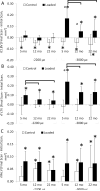Aging diminishes lamellar and woven bone formation induced by tibial compression in adult C57BL/6
- PMID: 24836737
- PMCID: PMC4091978
- DOI: 10.1016/j.bone.2014.05.006
Aging diminishes lamellar and woven bone formation induced by tibial compression in adult C57BL/6
Abstract
Aging purportedly diminishes the ability of the skeleton to respond to mechanical loading, but recent data show that old age did not impair loading-induced accrual of bone in BALB/c mice. Here, we hypothesized that aging limits the response of the tibia to axial compression over a range of adult ages in the commonly used C57BL/6. We subjected the right tibia of old (22 month), middle-aged (12 month) and young-adult (5 month) female C57BL/6 mice to peak periosteal strains (measured near the mid-diaphysis) of -2200 με and -3000 με (n=12-15/age/strain) via axial tibial compression (4 Hz, 1200 cycles/day, 5 days/week, 2 weeks). The left tibia served as a non-loaded, contralateral control. In mice of every age, tibial compression that engendered a peak strain of -2200 με did not alter cortical bone volume but loading to a peak strain of -3000 με increased cortical bone volume due in part to woven bone formation. Both loading magnitudes increased total volume, medullary volume and periosteal bone formation parameters (MS/BS, BFR/BS) near the cortical midshaft. Compared to the increase in total volume and bone formation parameters of 5-month mice, increases were less in 12- and 22-month mice by 45-63%. Moreover, woven bone incidence was greatest in 5-month mice. Similarly, tibial loading at -3000 με increased trabecular BV/TV of 5-month mice by 18% (from 0.085 mm3/mm3), but trabecular BV/TV did not change in 12- or 22-month mice, perhaps due to low initial BV/TV (0.032 and 0.038 mm3/mm3, respectively). In conclusion, these data show that while young-adult C57BL/6 mice had greater periosteal bone formation following loading than middle-aged or old mice, aging did not eliminate the ability of the tibia to accrue cortical bone.
Keywords: Aging; Bone formation; MicroCT; Mouse; Tibial compression.
Copyright © 2014 Elsevier Inc. All rights reserved.
Figures





Similar articles
-
Cortical and trabecular bone adaptation to incremental load magnitudes using the mouse tibial axial compression loading model.Bone. 2013 Jan;52(1):372-9. doi: 10.1016/j.bone.2012.10.026. Epub 2012 Oct 27. Bone. 2013. PMID: 23111313 Free PMC article.
-
Aged mice have enhanced endocortical response and normal periosteal response compared with young-adult mice following 1 week of axial tibial compression.J Bone Miner Res. 2010 Sep;25(9):2006-15. doi: 10.1002/jbmr.96. J Bone Miner Res. 2010. PMID: 20499381 Free PMC article.
-
Structural and Mechanical Improvements to Bone Are Strain Dependent with Axial Compression of the Tibia in Female C57BL/6 Mice.PLoS One. 2015 Jun 26;10(6):e0130504. doi: 10.1371/journal.pone.0130504. eCollection 2015. PLoS One. 2015. PMID: 26114891 Free PMC article.
-
Evaluation of loading parameters for murine axial tibial loading: Stimulating cortical bone formation while reducing loading duration.J Orthop Res. 2018 Feb;36(2):682-691. doi: 10.1002/jor.23727. Epub 2017 Oct 9. J Orthop Res. 2018. PMID: 28888055 Free PMC article.
-
Tibial compression is anabolic in the adult mouse skeleton despite reduced responsiveness with aging.Bone. 2011 Sep;49(3):439-46. doi: 10.1016/j.bone.2011.05.017. Epub 2011 May 27. Bone. 2011. PMID: 21642027 Free PMC article.
Cited by
-
Hallmarks of frailty and osteosarcopenia in prematurely aged PolgA(D257A/D257A) mice.J Cachexia Sarcopenia Muscle. 2020 Aug;11(4):1121-1140. doi: 10.1002/jcsm.12588. Epub 2020 Jun 28. J Cachexia Sarcopenia Muscle. 2020. PMID: 32596975 Free PMC article.
-
Gene expression of intracortical bone demonstrates loading-induced increases in Wnt1 and Ngf and inhibition of bone remodeling processes.Bone. 2021 Sep;150:116019. doi: 10.1016/j.bone.2021.116019. Epub 2021 May 21. Bone. 2021. PMID: 34023542 Free PMC article.
-
Conditional Activation of NF-κB Inducing Kinase (NIK) in the Osteolineage Enhances Both Basal and Loading-Induced Bone Formation.J Bone Miner Res. 2019 Nov;34(11):2087-2100. doi: 10.1002/jbmr.3819. Epub 2019 Jul 31. J Bone Miner Res. 2019. PMID: 31246323 Free PMC article.
-
Mechanosensitive Ca2+ signaling and coordination is diminished in osteocytes of aged mice during ex vivo tibial loading.Connect Tissue Res. 2020 May-Jul;61(3-4):389-398. doi: 10.1080/03008207.2020.1712377. Epub 2020 Jan 13. Connect Tissue Res. 2020. PMID: 31931640 Free PMC article.
-
Predicting cortical bone adaptation to axial loading in the mouse tibia.J R Soc Interface. 2015 Sep 6;12(110):0590. doi: 10.1098/rsif.2015.0590. J R Soc Interface. 2015. PMID: 26311315 Free PMC article.
References
-
- Parfitt AM. Bone remodeling in type I osteoporosis. J Bone Miner Res. 1991;6:95–7. - PubMed
-
- Ferguson VL, Ayers RA, Bateman TA, Simske SJ. Bone development and age-related bone loss in male C57BL/6J mice. Bone. 2003;33:387–98. - PubMed
-
- Kassem M, Marie PJ. Senescence-associated intrinsic mechanisms of osteoblast dysfunctions. Aging Cell. 2011;10:191–7. - PubMed
-
- Rianon NJ, Lang TF, Sigurdsson G, Eiriksdottir G, Sigurdsson S, Garcia M, Pajala S, Koster A, Yu B, Selwyn BJ, Taylor WC, Kapadia AS, Gudnason V, Launer LJ, Harris TB. Lifelong physical activity in maintaining bone strength in older men and women of the Age, Gene/Environment Susceptibility-Reykjavik Study. Osteoporos Int. 2012;23:2303–12. - PMC - PubMed
Publication types
MeSH terms
Grants and funding
LinkOut - more resources
Full Text Sources
Other Literature Sources
Medical

